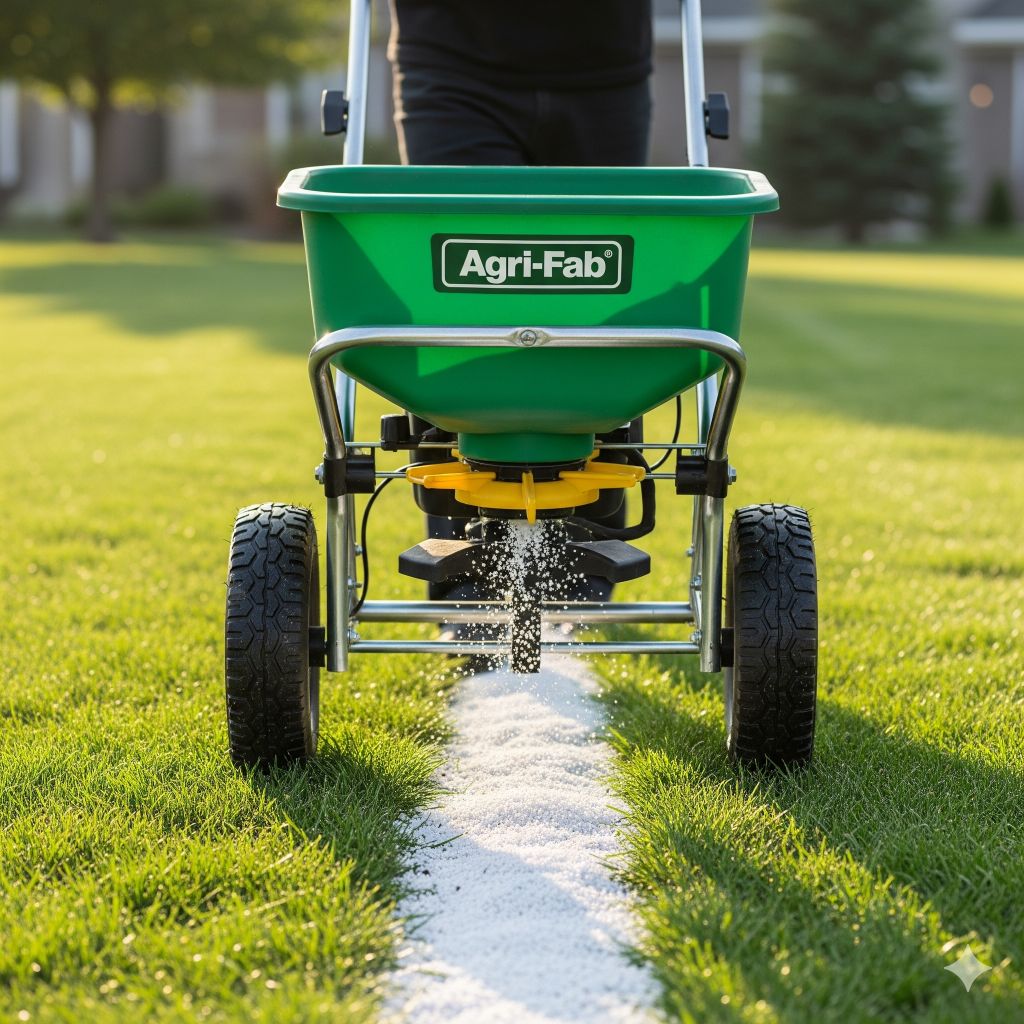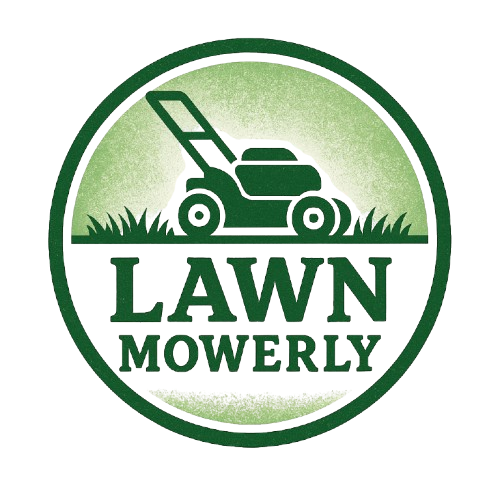
Whether you’re feeding a lawn, melting ice, or overseeding a field edge, getting the right spreader setting on an Agri‑Fab unit saves product and delivers even results. This guide explains how settings work, how to calibrate any Agri‑Fab spreader in under 10 minutes, and offers starter charts you can fine‑tune at your site. We also compare Agri‑Fab with other common brands and close with pro tips and FAQs.
Important note: Every material flows differently by particle size, coating, and moisture. Treat any chart as a starting point. Always calibrate before covering the whole area.
1) Spreader Settings 101
What a “setting” actually does.
- Agri‑Fab broadcast and drop spreaders use a control lever/dial to open a gate over the hopper throat. Higher numbers = larger opening = more product per distance.
- Tow‑behind models also change flow with ground speed and impeller speed (faster = heavier rate and wider throw). Push models depend on walking speed.
Two numbers matter more than the dial:
- Application rate (e.g., 3 lb per 1,000 sq ft for fertilizer, or 2.5 oz/yd² for ice melt).
- Coverage area of your bag. Example: 40 lb bag at 3 lb/1,000 sq ft covers ~13,300 sq ft.
Dial numbers are not universal. A “3” on one model will not match a “3” on another or on a different brand. That’s why you should calibrate (section 3).
2) Know Your Agri‑Fab Spreader Type
Broadcast (rotary) spreaders
- Throw granules in a fan pattern 6–12+ ft wide (model and speed dependent).
- Best for fertilizer, seed, and ice melt on medium–large areas.
Drop spreaders
- Drop material exactly the width of the hopper (e.g., ~17–22 in on many walk‑behinds).
- Best for precise work along beds, sidewalks, or windy sites.
Push vs. Tow‑Behind
- Push: simplest, great for 3k–12k sq ft lawns. Output depends on your walking speed (target 3 mph ≈ 100 ft in 23 seconds).
- Tow‑Behind: for 10k+ sq ft to acres. Calibrate to the tractor’s typical mowing gear at 3–4 mph.
3) 10‑Minute Calibration (Works for Any Agri‑Fab)
You’ll need: a scale, bucket or tarp, tape measure, and chalk.
- Know your target rate. Example: fertilizer label says 3.0 lb/1,000 sq ft.
- Mark a test lane. For push units, mark a 50 ft lane; for tow‑behind, mark 100 ft. Measure your spread swath (fan width) during a quick dry run.
- Calculate the test area. Area = lane length × swath width.
- Example: 50 ft lane × 8 ft swath = 400 sq ft.
- Weigh a charge of product into the hopper (e.g., 8–10 lb so the gate feeds consistently).
- Pick a starting setting from the charts (below) and run the lane at your normal speed (3 mph walk or mowing gear).
- Weigh what’s left in the hopper and subtract from the starting weight to learn how much you applied on the test area.
- Compare to target.
- Target for the example: 3.0 lb/1,000 sq ft × 400 sq ft = 1.2 lb should be applied.
- If you applied more than 1.2 lb, close the gate slightly (lower setting). If less, open a notch.
- Repeat once more to confirm. Record the final dial number + speed for this product.
Speed matters: Changes of 0.5 mph can swing rates by 10–20%. Keep your pace steady (use a metronome app or count steps).
4) Starter Settings Charts (Fine‑Tune by Calibration)
Below are conservative starting settings for common Agri‑Fab push and tow‑behind models. These are not brand‑official; they’re practical baselines to save you time. Because model dials differ, the numbers are given as fractions of gate opening (Low/Medium/High). Match that idea to your dial or lever, then calibrate.
4.1 Push Broadcast Spreaders (e.g., 50–85 lb class)
Target pace: 3 mph (100 ft in 23 sec). Typical fan width: 6–9 ft.
| Material & Target Rate | Low (light feed/seed) | Medium (standard fert) | High (heavy/fast dissolve) |
|---|---|---|---|
| Balanced lawn fertilizer (2.5–3.0 lb/1,000 sq ft) | 1.5–2.0 | 2.0–3.0 | 3.0–4.0 |
| High‑N spring fert (3.0–3.5 lb/1,000) | 1.5–2.5 | 2.5–3.5 | 3.5–4.5 |
| Starter fertilizer (1.0–1.5 lb/1,000) | 1.0–1.5 | 1.5–2.0 | 2.0–3.0 |
| Lime (pelletized) (10–15 lb/1,000) | 3.0–4.0 | 4.0–5.0 | 5.0–6.0 |
| Gypsum (10–15 lb/1,000) | 3.0–4.0 | 4.0–5.0 | 5.0–6.0 |
| Granular pre‑emergent (per label) | 1.5–2.5 | 2.0–3.0 | 3.0–4.0 |
| Granular post‑emergent (per label) | 1.0–2.0 | 2.0–3.0 | 3.0–4.0 |
| Ice melt (2–4 oz/yd²) | 2.0–3.0 | 3.0–4.0 | 4.0–5.0 |
| Grass seed – fine (blue/rye) (1.5–3 lb/1,000) | 0.5–1.0 | 1.0–1.5 | 1.5–2.0 |
| Grass seed – coarse (fescue/tall) (4–6 lb/1,000) | 1.0–1.5 | 1.5–2.5 | 2.5–3.5 |
Use half‑rate crosshatch on seed: apply 50% of the rate N–S, then 50% E–W for even coverage.
4.2 Push Drop Spreaders (17–22 in class)
Target pace: 3 mph. Swath equals hopper width.
| Material & Target Rate | Low | Medium | High |
|---|---|---|---|
| Balanced fertilizer (2.5–3.0 lb/1,000) | 2–3 | 3–4 | 4–5 |
| Lime (pelletized) (10–15 lb/1,000) | 4–5 | 5–6 | 6–7 |
| Seed – fine (1.5–3 lb/1,000) | 1–2 | 2–3 | 3–4 |
| Seed – coarse (4–6 lb/1,000) | 2–3 | 3–4 | 4–5 |
| Pre‑emergent (per label) | 2–3 | 3–4 | 4–5 |
Note: Walk your overlap marks carefully; the drop pattern is precise.
4.3 Tow‑Behind Broadcast Spreaders (85–130 lb class)
Target pace: 3–4 mph. Typical fan width: 8–12+ ft depending on impeller speed.
| Material & Target Rate | Light | Medium | Heavy |
|---|---|---|---|
| Balanced fertilizer (2.5–3.0 lb/1,000) | 2–3 | 3–4 | 4–5 |
| Pelletized lime (10–20 lb/1,000) | 3–4 | 4–6 | 6–7 |
| Gypsum (10–20 lb/1,000) | 3–4 | 4–6 | 6–7 |
| Ice melt (2–4 oz/yd²) | 2–3 | 3–4 | 4–6 |
| Grass seed – fine (1.5–3 lb/1,000) | 1–2 | 2–3 | 3–4 |
| Grass seed – coarse (4–6 lb/1,000) | 2–3 | 3–4 | 4–5 |
For tractors with variable throttle, pick the same gear and RPM you mow with and keep it constant.
5) How to Convert Labels to a Spreader Setting (Worked Examples)
Example A: Fertilizer, push broadcast
- Bag recommendation: 3.0 lb/1,000 sq ft. Lawn: 6,000 sq ft. Total product needed: 3 × 6 = 18 lb.
- Starter setting: use chart → Medium 2.0–3.0. Begin at 2.5.
- Mark a 50 ft test lane; dry run shows 8 ft fan width. Test area = 400 sq ft. Target on lane: 3.0 × 0.4 = 1.2 lb.
- After the pass at 3 mph, you used 1.4 lb (too heavy). Reduce to 2.25 and retest. Lock it in when you hit ~1.2 lb.
Example B: Overseeding tall fescue, tow‑behind
- Rate target: 5 lb/1,000 over 12,000 sq ft → 60 lb of seed.
- Start at Medium 3–4 on the tow‑behind chart. Begin at 3.5 and do a 100 ft lane at 10 ft swath → 1,000 sq ft. Target for the lane: 5 lb.
- First pass uses 4.2 lb (light). Open to 3.8; confirm ~5 lb.
6) Pattern, Overlap & Edging
- Double‑pass crosshatch (50% rate each direction) hides most small errors and gives the most uniform results.
- Edge guard / deflector: When spreading near flower beds, water, or pavement, use a deflector or close the gate for the first stripe along the edge.
- Turn technique: Close the gate before stopping or turning, then reopen when straight. This prevents “donuts” of excess product.
- Wind: With broadcast spreaders, spread with the wind on the first pass, then perpendicular; avoid gusts above ~10–12 mph for seed.
7) Maintenance That Affects Your Setting
- Clean and dry after use—fertilizer salts attract water and corrode linkages, changing gate travel over time.
- Inspect the cable/rod from lever to gate for slack; adjust so “0” fully closes the plate.
- Impeller: Check for cracks or wobble; a worn impeller throws a lopsided pattern.
- Gate plate: Make sure it opens symmetrically. Bent plates starve flow; replace if distorted.
- Agitation: Some products bridge. A light shake or optional agitator kit helps maintain flow at low settings.
- Lubrication: Dry graphite on the slide/gate as needed—avoid oily lubes that collect dust.
8) Agri‑Fab vs Scotts vs EarthWay vs Brinly
| Brand | Typical Use Case | Notable Strengths | Watch‑outs |
|---|---|---|---|
| Agri‑Fab | Homeowners to acreage; lots of tow‑behind options | Value, parts availability, simple controls | Dial scales vary by model; calibrate once per product |
| Scotts | Homeowners with branded fertilizers | Matching charts for Scotts products | Less flexible for tow‑behind; proprietary numbering |
| EarthWay | Prosumers/contractors | Even rotary pattern, high‑end pneumatic wheels (on some) | Price; still needs calibration across materials |
| Brinly | Homeowners/acreage | Robust hoppers, good tow‑behind lineup | Gate linkage slack if not maintained |
Takeaway: All brands require calibration; Agri‑Fab is a cost‑effective platform especially for tow‑behind work.
9) Troubleshooting Poor Results
- Striping (light/dark bands): Speed varied; pattern too narrow; overlap inconsistent. Fix by crosshatching at half‑rate and re‑calibrating.
- Clumping at the gate: Material damp; sieve clods; store indoors; consider a small agitator.
- Uneven fan (broadcast): Impeller dirty or bent; hopper not centered over vanes; correct and test with dry sand.
- Too much product at starts/stops: Forgetting to close gate; add a habit—“close on turn, open on line.”
- Running out too fast: Setting too high for the target rate; your ground speed is higher than planned.
10) Quick Reference: Rate & Area Conversions
- Square feet per acre: 43,560.
- 1,000 sq ft = 0.02296 acre.
- Pounds per acre (lb/A) = (lb/1,000 sq ft) × 43.56.
- Example: 3.0 lb/1,000 = 130.7 lb/A.
- Bag coverage: Coverage (sq ft) = (Bag weight ÷ rate) × 1,000.
- Example: 40 lb at 3.0 lb/1,000 → 13,333 sq ft.
- Metric: 1 lb/1,000 sq ft ≈ 48.8 g/m².
11) Pro Tips from the Field
- Prime the hopper: Start with at least 10–15 lb of product in large hoppers so flow is smooth at low settings.
- Chalk the edges: Snap chalk lines to keep stripes parallel.
- Mark the dial: Once calibrated, put a paint tick at the exact notch for that product.
- Label cards: Keep a zip‑bag of index cards in the hopper lid with product name, dial, speed, and date.
- Seasonal humidity: Granules absorb moisture and flow slower in monsoon season—open 0.25–0.5 notch and recalibrate.
- Safety: Wear eye protection and gloves when handling herbicide/fertilizer blends.
Agri-Fab spreader settings broken down by use case and product type (Scotts fertilizers, GrubGONE, tow-behind vs push, drop vs rotary, etc.). Since Agri-Fab doesn’t publish universal dial-to-product charts (numbers vary by model), the best approach is to give you starting points and show how they translate across those categories.
Agri-Fab Spreader Settings Reference
Here’s a consolidated reference you can use (all need fine-tuning by calibration as in the guide I drafted for you):
1. Scotts Fertilizers in Agri-Fab Spreaders
- Scotts Turf Builder / Weed & Feed → Start at 2.5–3.0 (medium gate) on a push broadcast model at 3 mph.
- Scotts Starter Fertilizer → Start at 1.5–2.0 (lighter gate).
- Scotts WinterGuard → Start at 2.0–2.5.
Scotts publishes settings for their own spreaders (EdgeGuard, SpeedyGreen, etc.). For Agri-Fab, use the bag’s rate (e.g., 2.8 lb/1,000 sq ft) → then run a test lane and adjust.
2. Agri-Fab Pull-Behind (Tow-Behind) Settings
- Balanced Fertilizer (10-10-10, 12-12-12) → 3–4 medium gate, 3–4 mph.
- Pelletized Lime or Gypsum → 4–6 medium-high.
- Grass Seed (fine) → 2–3, light to medium gate.
- Grass Seed (tall fescue, coarse) → 3–4.
3. GrubGONE (Bacillus thuringiensis galleriae granules)
- Label rate: 2.0–2.5 lb/1,000 sq ft.
- Agri-Fab broadcast (push or tow) → start at 2.5–3.0 on medium gate.
- Do a calibration test lane: Target ~1.0 lb per 400 sq ft (if testing a 50 ft × 8 ft swath).
4. Agri-Fab Broadcast (Rotary) Settings
- General Fertilizer → 2.5–3.0 medium.
- Seed (fine) → 1.0–2.0 light.
- Seed (coarse) → 2.0–3.0 medium.
- Ice Melt → 3.0–4.0 medium-high.
5. Agri-Fab Drop Spreader Settings
- Balanced Fertilizer → 3–4 medium.
- Seed (fine) → 2–3 light-medium.
- Seed (coarse) → 3–4 medium.
- Pre-emergent herbicide granules → 3–4.
6. Agri-Fab Rotary vs Drop (Quick Compare)
| Type | Best For | Typical Gate Range | Notes |
|---|---|---|---|
| Broadcast/Rotary | Fertilizer, seed, ice melt, large areas | 2–4 (medium) | Wide fan, overlap required |
| Drop | Precise strips, beds, sidewalks | 2–4 (medium) | No scatter; exact swath width |
✅ Pro tip: No matter the product (Scotts, GrubGONE, lime, or seed), always:
- Take the bag rate in lb/1,000 sq ft.
- Run a calibration lane (50 ft × swath for push; 100 ft × swath for tow).
- Adjust gate until product used in that lane = target weight.
Here’s your information re-written cleanly in a chart format so it’s easier to reference and print:
Agri-Fab Spreader Recommended Settings by Material
| Material Type | Flow Setting | Spread Width | Recommended Speed |
|---|---|---|---|
| Powdered Fertilizers | 3 – 5 | 3 – 4 in | 3 mph |
| Granular Fertilizers | 3 – 5 | 8 – 10 in | 3 mph |
| Pelletized Fertilizers | 3 – 5 | 10 – 12 in | 3 mph |
| Organic Fertilizers | 6 – 8 | 6 – 8 in | 3 mph |
| Fine Grass Seed | 3 – 4 | 6 – 7 in | 3 mph |
| Rough Grass Seed | 4 – 5 | 8 – 9 in | 3 mph |
| Ice Melters | 6 – 8 | 10 – 12 in | 3 mph |
✅ This gives you a quick-start reference: just pick the material type, set the gate within the suggested range, maintain a steady 3 mph pace, and then fine-tune by calibration for exact coverage.
12) Frequently Asked Questions (FAQ)
Q1. Why doesn’t my dial number match the one I saw online?
Because dials vary by model year and gate geometry. Use charts only as a starting point, then calibrate with a short test lane.
Q2. Can I use the same setting for fertilizer and seed?
Not reliably. Seed flows differently. Start with the seed row in the chart and recalibrate.
Q3. My tow‑behind throws heavier on the left—what’s wrong?
Check impeller vanes for wear, and ensure the hopper throat is centered over the impeller. Level the spreader front‑to‑back.
Q4. How fast should I walk?
Aim for 3 mph—100 ft in ~23 seconds. Practice on a driveway with a stopwatch.
Q5. What about ice melt in winter?
Use the Ice Melt row as a start. Keep material dry, avoid over‑application near concrete or plants, and sweep excess.
Q6. Will opening the gate more just finish faster?
Yes—but at the cost of accuracy and burning grass. Match gate opening to the labeled rate; don’t “rush” with an oversized opening.
Q7. Is crosshatching necessary?
On high‑visibility lawns, yes—it evens out micro‑variations in speed and pattern. For coarse products like lime, it’s very helpful.
Q8. How often should I recalibrate?
Any time you change product, after repairs, or if your application speed changes. Otherwise, once per season is fine.
Final Word
The fastest path to perfect results is simple: calibrate once, then reuse your saved setting for that product. With Agri‑Fab’s straightforward mechanisms and the steps above, you’ll spread accurately, avoid stripes, and make every bag count.

I’m David man behind Lawn Mowerly; I’ve been dealing with lawnmowers and Tractors with my father since I was a kid. I know every make and model and what each one is capable of and love helping people find the perfect equipment for their needs.
